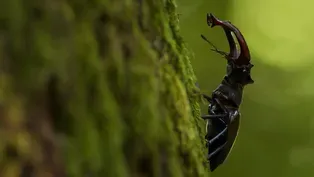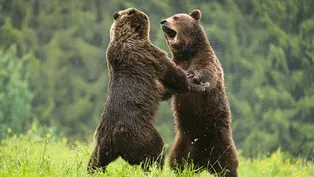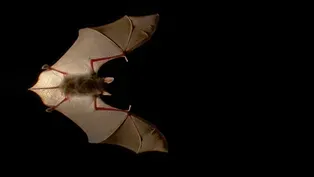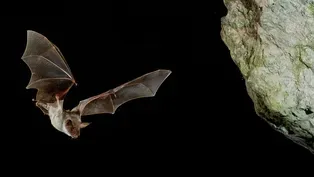
Filming Transylvania's Elusive Wildlife
Clip: Season 43 Episode 2 | 8m 25sVideo has Closed Captions
Irish director John Murray sets out to reveal the natural wonders of Transylvania.
Learn about the personal passion and stories that went into the creation of "Dracula’s Hidden Kingdom," as Irish director John Murray sets out to reveal the natural wonders of Transylvania. To reveal Transylvania's creatures' intimate lives, the production company teamed up with filmmakers from Romania and set about filming and setting camera traps across the region.
Major support for NATURE is provided by The Arnhold Family in memory of Henry and Clarisse Arnhold, The Fairweather Foundation, Sue and Edgar Wachenheim III, Charles Rosenblum, Kathy Chiao and...

Filming Transylvania's Elusive Wildlife
Clip: Season 43 Episode 2 | 8m 25sVideo has Closed Captions
Learn about the personal passion and stories that went into the creation of "Dracula’s Hidden Kingdom," as Irish director John Murray sets out to reveal the natural wonders of Transylvania. To reveal Transylvania's creatures' intimate lives, the production company teamed up with filmmakers from Romania and set about filming and setting camera traps across the region.
How to Watch Nature
Nature is available to stream on pbs.org and the free PBS App, available on iPhone, Apple TV, Android TV, Android smartphones, Amazon Fire TV, Amazon Fire Tablet, Roku, Samsung Smart TV, and Vizio.
Buy Now

Explore More Ways to Watch
Bring the beauty and wonders of wildlife and natural history into your home with classic NATURE episodes.Providing Support for PBS.org
Learn Moreabout PBS online sponsorship- About 12 years ago, my wife had a week-long trip to film the bears of Transylvania, and she came back to Ireland and was just blown away by her experience in Transylvania.
She just couldn't get over how wild and beautiful and wonderful it was.
Eventually we decided, "Okay, we have to do this."
And so we managed to get partners on board and we're setting out now to spend two years in Transylvania, trying to capture its wild wonders.
Now Transylvania is part of Romania.
It sits in southeastern Europe, and it's a fair distance away from where we are in Ireland.
So little bit of logistics to get there, and it's an amazing place.
It's this historical region of mountains, of great forests, and wonderful people of all kinds.
Romanians, Hungarians, people of German origin all living there.
Transylvania's key treasures are its wild forests.
It has some of the last intact ancient forests left in Europe.
And in there, you find the apex predators, the wolves, the lynx, and we are hoping over the next while to capture them.
There are a lot of bears in Transylvania, perhaps as much as half of Europe's remaining bears.
So there are various places where they do come out into clearings and openings and we're hoping to be able to film them.
The lynx is probably the most elusive of all of them.
They are really wary, and even the locals who've been working and living close to the forest for decades rarely if ever get a glimpse of a lynx.
They're just so careful about being spotted.
There are lots of wolves in Transylvania.
The forests are vast and the wolves find plenty of space to roam and to find prey.
A huge advantage to us is that when we were doing our research, we met some local wildlife filmmakers from Transylvania who are world class and have made films that have been seen around the world.
So we got on really well with them.
And so we've teamed up, Dan Dinu being one of them, Cosmin Dumitrache the other, and so they're helping us as a team to make this film over the next while.
And their expertise in knowing the terrain and knowing the woods and knowing the mountains is going to be absolutely invaluable.
- Filming animals in Romania is not easy at all because the wild places that we have here are still big.
The forests are still complicated to travel in, and sometimes you need a lot of work to do that.
Also, we still have hunting, we still have poaching in some areas unfortunately, so that means that animals are scared of people.
Sometimes it's complicated just to find tracks, and when you want to actually film them, it's quite tricky.
- Dan and Remus are going to work on the camera traps in particular.
These are high quality cameras that we will leave in boxes out in the wilds for months, hoping to capture animals that are just impossible to film otherwise.
So Dan and Remus, with their knowledge of the mountains and the paths that these animals take, are going to head off, put the cameras in various places, on tracks, in trees, places where they know the animals in the past have visited, and hopefully over the next while, we'll see the results.
(bright music) - I'm doing this in Romania for more than 10 years, working for projects regarding wild animals, trying to photograph them especially, and I only got one chance to see one wolf and one lynx.
So the camera traps is the only thing that you can actually do.
The technical part of camera trapping was also quite complicated, and Remus was the best man to have around because he's an engineer.
First of all, it was complicated to find good areas, and the second thing was because it was a lot of work with the camera traps.
Sometimes they were working, sometimes they're not working.
A lot of the animals came at night, so we did almost anything that we can do to catch those animals in front of the camera.
(bright music) - [John] Camera traps are challenging in the sense that they always go wrong, so you really have to be careful and know what you're at to make them valuable to the production.
Every time you put out 10 traps, six of them don't work.
And you just have to be incredibly fastidious in terms of prepping the cameras and making sure that everything is set up properly before you leave for weeks.
- [Dan] Peter, this is the shot.
And all the time we had problems, or we had, I don't know, surprises, some of the areas were quite remote, so we need to bring a lot of batteries back then to have the cameras working for two, three weeks.
And sometimes it was just maybe one small cable that broke or it was not good enough and we ruined two or three weeks of filming.
So it's always a dynamic job to do this kind of filming.
(gentle music) You need to like technical parts to be able to do this kind of job, and I hope that at the end, we get the footage that we wanted, let's say we got the footage with the animals that wanted to be in the film.
- [John] One of the most striking things about Transylvania is its extraordinary wildflower meadows.
Europe would've been once covered in these traditional meadows.
Ireland used to be, isn't anymore, and the color and diversity and the insect life in them in spring and summer is just staggering.
And you walk in and you go, "Oh, this is what traditional meadows and traditional grasslands should be like."
Transylvania, like most of Europe, is losing them because agriculture is advancing and modernizing, but there are still corners of Transylvania where the wildflower meadows are magnificent.
And we hope to film there and feature the different kind of plants and insects that make their homes there and show just how rich and remarkable they are.
(bright music) We really wanted not just to cover the wildlife of Transylvania, but also to bring in some of the culture and history, and so we plan to do that.
There are wonderful festivals in springtime when the local village girls and women go off into the wildflower meadows and gather the flowers as a kind of a celebration of fertility and of life.
(birds cawing) (dramatic music) One other aspect we'd like to feature is the amazing castles and ruins and forts and churches that lie all over Transylvania, extraordinary buildings that have sat there for five and 600 years and seen amazing history.
I've just recently started to get to know Transylvania, and I am just blown away by the richness and diversity of the place.
To see mountain after mountain after mountain draped in ancient forest, to see clear crystalline rivers obviously completely clean, to get a sense that this is how the world once was is just such a privilege.
I'm so looking forward to spending the next year, year and a half here, getting to know it better, getting to know the people better, getting to know its wildlife better.
(bright music)
Video has Closed Captions
This stag beetle has just weeks to find a mate before he dies. (1m 57s)
Video has Closed Captions
Finding a mate is no easy task for this male bear. (2m 22s)
Meet the Bats of Dracula's Home
Video has Closed Captions
Transylvania is a wonderland for bats. (2m 55s)
Preview of Dracula’s Hidden Kingdom
Video has Closed Captions
Discover the wildlife of Transylvania, a mysterious region hiding some of Europe’s last wilderness. (30s)
Providing Support for PBS.org
Learn Moreabout PBS online sponsorshipMajor support for NATURE is provided by The Arnhold Family in memory of Henry and Clarisse Arnhold, The Fairweather Foundation, Sue and Edgar Wachenheim III, Charles Rosenblum, Kathy Chiao and...















